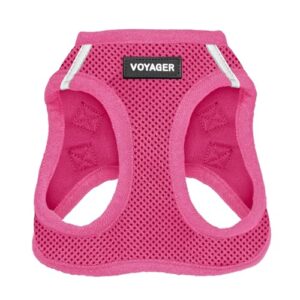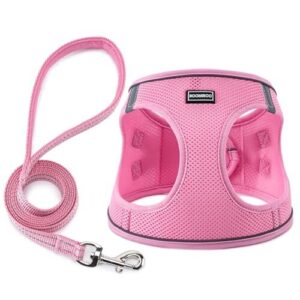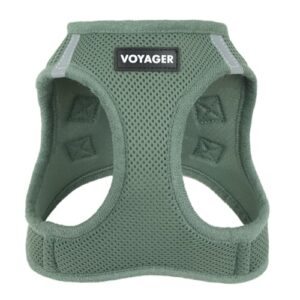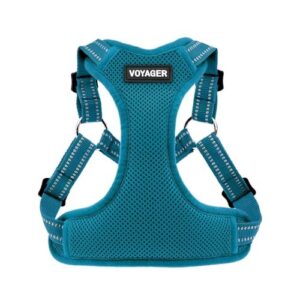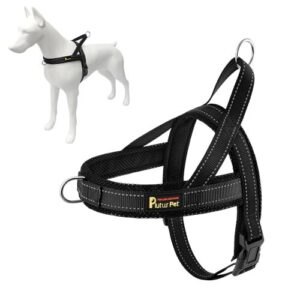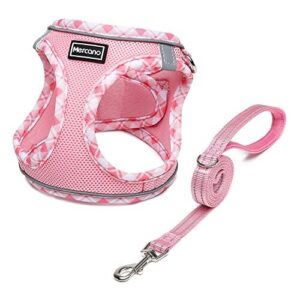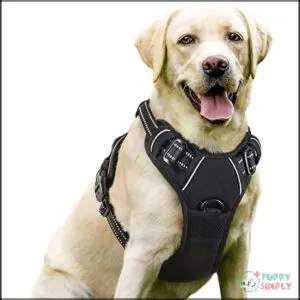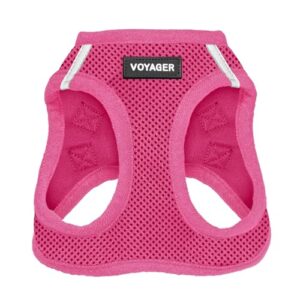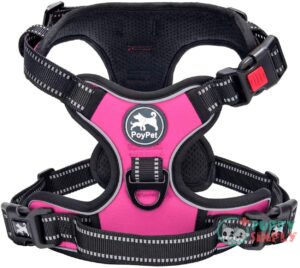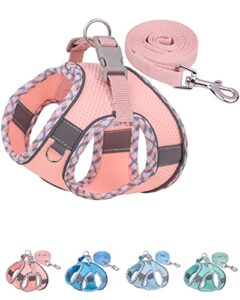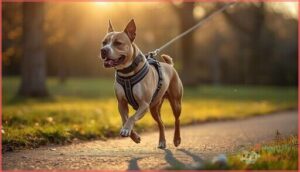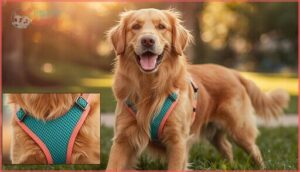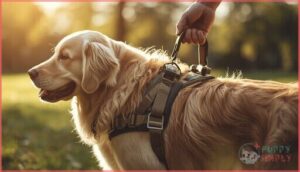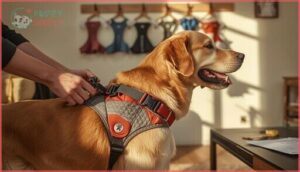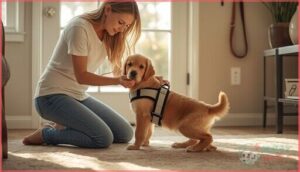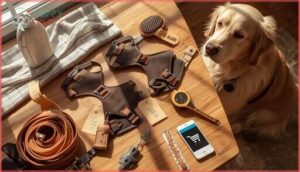This site is supported by our readers. We may earn a commission, at no cost to you, if you purchase through links.
Your dog pulls hard on walks. The leash yanks tight. You feel the strain in your arm. Your dog coughs from collar pressure. This happens to most dog owners at some point.
Pet chest plates solve this problem by spreading pressure across your dog’s chest instead of concentrating it on the neck. They give you better control without causing discomfort or injury. A good chest plate transforms daily walks from a struggle into an enjoyable experience for both of you.
The right chest plate depends on your dog’s size, behavior, and activity level. This guide reviews ten top-rated options and shows you how to pick the best one.
Table Of Contents
- Key Takeaways
- Best Pet Harnesses for Dogs: Top 10 Picks
- 1. Best Pet Supplies Voyager Harness
- 2. Boomiboo Pink Dog Harness Leash Set
- 3. Voyager Step In Air Dog Harness
- 4. Voyager Mesh Dog Harness Turquoise Small
- 5. Plutus Pet No Pull Dog Harness
- 6. Soft Mesh Step-In Dog Harness Set
- 7. rabbitgoo No Pull Dog Harness Large
- 8. Best Pet Supplies Voyager Air Harness
- 9. PoyPet No Pull Dog Harness Vest
- 10. Petank Dog Harness Leash Set
- Key Features and Benefits of Dog Harnesses
- Comparing Harnesses Vs. Collars for Dogs
- Types of Dog Harnesses Explained
- How to Choose The Right Harness
- Harness Training and Proper Usage
- Care, Maintenance, and Shopping Tips
- Frequently Asked Questions (FAQs)
- How tight should a dog harness be?
- Can I leave a harness on my dog all the time?
- What’s the best harness for a dog that pulls?
- Should I get a harness for my puppy?
- Is it okay for my dog to wear a harness and a collar at the same time?
- Are dog harnesses safe for car travel?
- Can puppies safely wear harnesses from a young age?
- Which harnesses are escape-proof for anxious dogs?
- Is it possible to personalize or custom-fit a harness?
- Conclusion
Key Takeaways
- Chest plate harnesses reduce pulling and protect your dog’s neck by spreading pressure across the chest instead of the throat.
- Adjustable and no-pull harness designs with front leash clips give you more control and help with leash training.
- Getting the fit right is crucial—always measure your dog’s chest and neck to ensure comfort and prevent escape or injury.
- Regular checks, proper cleaning, and choosing harness types based on your dog’s size, breed, and activity keep walks safe and comfortable.
Best Pet Harnesses for Dogs: Top 10 Picks
Finding the right dog vest can make walks safer and easier for you and your dog. Here are ten top picks that stand out for comfort, control, and reliability.
Let’s look at what sets each one apart.
1. Best Pet Supplies Voyager Harness
The Best Pet Supplies Voyager Vest puts safety and comfort first. Its heavy-duty mesh delivers material quality you can trust for outdoor walks year-round.
Customers praise the triple safety elements: hook and loop fastener, buckle, and double D-rings—all key dog vest features to look for. Sizing accuracy is important, so measure your dog’s chest for the best fit.
Market trends show this Voyager Step In Air Dog Vest remains a favorite because of its easy adjustments, secure design, and strong customer reviews.
Best For: Pet owners with small to medium dogs or cats who want an easy-to-use, secure, and comfortable harness for daily walks.
- Soft, breathable air mesh keeps pets cool and comfortable in any season.
- Triple security system with reflective bands ensures safety and visibility, day or night.
- Step-in design and adjustable fit make it quick to put on and prevents escape.
- Sizing may be confusing; requires careful measurement and may run large.
- Not suitable for large dogs or breeds with chests above 23 inches.
- Some variance in product color and fit reported when ordering online.
2. Boomiboo Pink Dog Harness Leash Set
If you’re looking for a dog harness with comfort and control, the Boomiboo Pink Dog Harness Leash Set stands out. Its double-layered mesh and cotton material composition offers a comfortable fit, while adjustable collar points confirm sizing accuracy for your pet.
Reflective safety threads boost nighttime visibility, and sturdy buckle durability means you can trust it for daily use. Two leash attachment rings give you flexible control.
This pet accessory set makes outdoor walks smoother and safer for both you and your dog.
Best For: Pet owners who want a comfortable, secure, and easy-to-use harness for small to medium dogs or cats, especially for safe nighttime walks.
- Adjustable fit and breathable mesh keep pets comfortable during long walks.
- Reflective stitching adds safety for evening or early morning outings.
- Easy step-in design and quick-release buckles make it simple to put on and take off.
- Sizing can be tricky, so measuring your pet before buying is essential.
- Some users report receiving incorrect sizes or colors.
- The dual metal rings may feel bulky and could need extra accessories for leash attachment.
3. Voyager Step In Air Dog Harness
You want a dog walking aid that puts safety first and feels good for your dog. The Voyager Step In Air Dog Walking Aid fits the bill with its soft air mesh comfort and step-in design—easy for quick walks.
Reflective safety bands help keep your pet visible at night. Weather resistance means you won’t worry about rain or heat.
Just remember, sizing inconsistencies can pop up, so measure your dog’s chest before buying. For everyday dog walking, this dog walking aid offers reliable control and peace of mind.
Best For: Small to medium-sized dogs (and cats) who need a secure, comfortable harness for everyday walks and better visibility at night.
- Soft, breathable mesh keeps pets cool and comfy.
- Triple security features prevent escapes and boost safety.
- Easy step-in design makes putting it on quick and hassle-free.
- Sizing can be inconsistent, so careful measuring is needed.
- Not suitable for large dogs.
- May not work well for pets who dislike step-in harnesses.
4. Voyager Mesh Dog Harness Turquoise Small
If you’re after mesh breathability and dog safety, the Voyager Mesh Dog Vest Turquoise Small stands out. Its step-in design saves time for busy mornings, while the turquoise color adds a pop of style. Reflective safety bands boost visibility during evening strolls.
Adjustable straps help you achieve a snug fit, which matters for growing pups or small breeds. Dog vest features and benefits like lightweight comfort and sturdy D-rings make this a smart pick for everyday use. Always check sizing for the best fit.
Best For: Small dog owners who want an easy-to-use, breathable harness with extra safety features for everyday walks.
- Soft, breathable mesh keeps dogs comfortable, even on long outings
- Reflective 3M piping and bands improve visibility in low light
- Step-in design and adjustable straps make it quick to put on and get a good fit
- Sizing can run small, so measuring your dog is a must
- May not work well for dogs that slip out of harnesses easily
- Plastic pieces on the sides can be uncomfortable for dogs when lying down
5. Plutus Pet No Pull Dog Harness
Control is key for any walk, and the Plutus Pet No Pull Dog Restraint puts it in your hands. Its adjustable chest and sturdy D-ring help you steer strong pullers, making training usage easier.
User reviews highlight restraint effectiveness for large dogs and praise the breathable mesh for comfort. While build quality stands out, some mention sizing issues and rubbing behind the armpits.
If you’re after dog safety and reliable dog restraint features and benefits, this NoPull Restraint is a smart choice for everyday outings.
Best For: Owners of small to large dogs who want a comfortable, easy-to-use harness that helps reduce pulling during walks and outdoor activities.
- Quick step-in design with one buckle makes it easy to put on and take off.
- Breathable mesh padding keeps dogs comfortable and cool.
- Reflective straps and sturdy hardware add safety and durability.
- Some users report rubbing behind the armpit area.
- Occasional sizing and quality control issues.
- May not fully prevent pulling for very strong or determined dogs.
6. Soft Mesh Step-In Dog Harness Set
A step-in lead like the Soft Mesh Step-In Dog Lead Set puts dog comfort and pet safety front and center. Mesh breathability keeps your dog cool on walks, while the step-in design makes it easy for you to secure a proper dog lead fit. Reflective safety stripes boost nighttime visibility. Material durability means this lead stands up to daily use.
Fitting considerations matter—always measure your dog’s chest for accuracy. With these dog lead features, you get control and comfort in one simple package.
Best For: Small dog and cat owners who want an easy-to-use, comfortable, and safe harness for daily walks and outdoor activities.
- Step-in design and quick-release buckle make it simple to put on and take off
- Breathable mesh and no-choke fit keep pets comfortable and secure
- 360° reflective stripes improve visibility for safer nighttime walks
- Only fits small dogs and cats, so not suitable for larger breeds
- Velcro fastener may wear out with frequent use
- Leash length may be too short for owners who prefer more roaming space
7. rabbitgoo No Pull Dog Harness Large
Balance is key with the rabbitgoo No Pull Dog Vest Large. This Dog Vest stands out for Vest Effectiveness—two leash rings and a sturdy handle give you better control, especially with strong breeds.
Comfort Factors matter, and soft padding plus adjustable straps help you get the right Dog Vest Fit. Reflective threads support Dog Safety and Comfort during night walks.
Breed Suitability leans toward medium and large dogs. Watch for Durability Issues with plastic buckles, and always check fit to address Safety Concerns.
Best For: Owners of medium to large dogs who need better control and comfort during walks, especially for strong pullers.
- No-pull design with two leash rings helps reduce pulling and improves control.
- Soft padding and adjustable straps offer comfort and a customizable fit for large breeds.
- Reflective material boosts safety during nighttime walks.
- Plastic buckles may wear out or break over time.
- Not suitable for small dogs or those with unique sizing needs.
- Handle could be thicker for easier grip and control.
8. Best Pet Supplies Voyager Air Harness
Ever wonder how much difference a chest plate can make on daily walks? The Best Pet Supplies Voyager Air Chest Plate puts Air Mesh Comfort front and center, keeping your pet cool and happy. Reflective Stitching boosts safety when daylight fades.
Triple Security—hook and loop, buckle, and double D-rings—means less worry about escapes. The Step-In Design makes gearing up simple.
Size Considerations matter, so measure carefully for the best Dog chest plate fit. This Voyager Step In Air Dog Chest Plate brings reliable Dog walking equipment to everyday adventures.
Best For: Pet owners with small to medium dogs or cats who want a comfortable, secure, and easy-to-use harness for daily walks.
- Soft, breathable mesh keeps pets cool and comfortable in any weather
- Triple security system and reflective bands boost safety and peace of mind
- Step-in design makes it quick and hassle-free to put on or take off
- Sizing runs a bit large and requires careful measurement for a good fit
- Not suitable for large dogs
- Some pets may resist wearing it or try to escape
9. PoyPet No Pull Dog Harness Vest
Looking for a vest that manages pulling without the fuss? The PoyPet No Pull Dog Vest delivers with front and back leash attachment points for better control during dog walking. Four adjustable straps with quick-release buckles let you dial in the perfect fit. Reflective stitching adds dog safety after dark.
User experiences highlight real improvements in pulling behavior, though some note the vest feels a bit heavy. The breathable air mesh and soft padding mean comfort, while the oxford fabric ensures material quality. Design flaws like limited tag space are minor trade-offs for this effective no-pull vest solution.
Best For: Dog owners struggling with pulling issues who want a comfortable, adjustable vest with dual attachment options for better walk control.
- Front and back leash clips give you flexibility to manage pulling behavior based on your dog’s needs
- Four adjustable straps with quick-release buckles make it easy to get the right fit fast
- Reflective stitching keeps your dog visible during early morning or evening walks
- Some users find the harness heavier than expected, which might bother smaller dogs
- Adjusting the four straps can be tricky to get just right at first
- Limited space for attaching ID tags or other accessories you might need
10. Petank Dog Harness Leash Set
The Petank Dog Vest Leash Set brings mesh breathability and a step-in design that makes getting your dog ready simple. Available in XXS through L sizes, this adjustable vest offers reflective safety features for low-light walks. The jacquard mesh fabric keeps air moving while the Velcro closure won’t snag fur.
At $7.88, this pet gear delivers solid value, though sizing limitations mean larger dogs need different dog supplies. The buckle durability raises concerns if your dog chews, but the adjustable comfort and lightweight build work well for puppies and smaller breeds.
Best For: Small to medium dogs and growing puppies whose owners want an easy-to-use, breathable harness with reflective safety features at a budget-friendly price.
- Step-in design with Velcro closure makes it quick to put on without snagging fur, perfect for squirmy dogs
- Jacquard mesh material keeps your dog cool and comfortable during walks in warm weather
- Reflective strips boost visibility during early morning or evening walks for added safety
- Buckle may break if your dog likes to chew on their gear
- Mesh material can get dirty quickly and might be tough to clean thoroughly
- Won’t help much with pulling or controlling strong dogs who tug on the leash
Key Features and Benefits of Dog Harnesses
Choosing the right restraint can make every walk safer and more comfortable for your dog. There are a few key features that set the best restraints apart.
Here’s what to look for as you compare your options.
No-Pull Harnesses and Leash Attachments
When your dog pulls like a freight train, no-pull restraints with front attachment points redirect that energy back toward you. These restraints feature 2 leash attachments – a back leash clip for casual walks and front attachment for pulling reduction.
The attachment mechanics apply gentle pressure to discourage lunging while preventing injury through proper restraint fitting and training integration. These restraints help to improve a dog’s leash walking skills.
Reversible and Adjustable Harness Designs
Beyond basic pulling control, reversible and adjustable restraint designs offer smart solutions for growing dogs and style-conscious owners. Adjustable restraints feature 3-4 adjustment points that accommodate 20-30% size variation, while reversible dog restraints use interchangeable fabric panels for different looks. These ergonomic innovations provide customization options that extend usability by 6-12 months. A key feature is the reversible restraint design, offering two styles in one.
- Material advancements include breathable mesh and eco-friendly polyester for enhanced comfort
- Versatility benefits allow one restraint to serve multiple functions and aesthetic preferences
- Market preferences show 85% of veterinary professionals recommend adjustable restraints for adaptability
Chest Protection and Lifting Support
While adjustability matters, chest protection and lifting support represent the core safety features that set quality harnesses apart. Chest harnesses distribute pressure evenly across your dog’s torso, preventing tracheal damage and neck injuries that collars can cause.
Support harnesses with ergonomic design help senior dogs navigate stairs and assist during recovery, while proper material selection ensures comfort during lifting assistance.
Versatile Attachment Points for Control
Multiple leash attachment points give you real control options. Front clips reduce pulling by redirecting your dog’s movement, while back clips allow freedom during relaxed walks. Dual-clip harnesses let you switch between training mode and recreational walking instantly.
Quality D-ring hardware ensures durability, and some models include car safety attachments for vehicle restraint during travel.
Comparing Harnesses Vs. Collars for Dogs
When choosing between a chest plate and collar for your dog, the differences go beyond just looks. Each option affects your pet’s safety, comfort, and control during walks.
Let’s break down the key areas where chest plates and collars stack up against each other.
Safety and Injury Prevention
Your dog’s safety depends on the right equipment choice. Crash test failures reveal most harnesses don’t protect during accidents, but they still beat collars for daily walks. Neck injury risks drop considerably when pressure spreads across the chest instead of concentrating on the throat.
Biomechanical impact studies show harnesses prevent the harmful neck extension that collars cause during pulling.
| Safety Factor | Harnesses | Collars |
|---|---|---|
| Neck Protection | Distributes force across chest | Concentrates pressure on throat |
| Injury Prevention | Reduces tracheal damage risk | Can cause neck/spine injuries |
| Travel Safety | Some crash-tested options available | No crash protection |
Comfort and Pressure Distribution
Comfort transforms every walk into a pleasant experience for both you and your dog. Dog lead pressure points concentrate in the chest area, averaging 1.14 to 2.02 N/cm² depending on design. Padding material greatly reduces discomfort, while adjustable dog lead benefits include better pressure distribution across wider areas.
| Comfort Factor | Dog leads | Collars |
|---|---|---|
| Pressure Distribution | Spreads across chest and shoulders | Concentrates on neck/throat |
| Biomechanical Impact | Minimal gait alteration with proper fit | Can restrict natural movement |
| Long-term Comfort | Padded designs prevent chafing | Risk of tracheal irritation |
| Material Benefits | Neoprene and soft fabrics cushion contact | Limited padding options |
Control During Walks and Training
If you want genuine control during walks, equipment-assisted training is the game changer. Leash attachment points on a well-fitted dog equipment for pulling give you leverage, reducing pulling and handler injuries. Dog training is safer, too—behavioral modification comes faster with equipment than collars, easing leash training. Consider leash attachment and comfort when choosing gear for dog walking.
| Feature | Equipment | Collar |
|---|---|---|
| Reducing Pulling | High | Low |
| Behavioral Modification | Easy | Challenging |
| Handler Injuries | Less | More |
Types of Dog Harnesses Explained
Dog harnesses come in all shapes and styles, each made for different needs and activities. Knowing what sets them apart can help you pick the best fit for your pup.
Here’s a quick look at the main types you’ll find.
No-Pull Dog Harnesses
When pulling turns every walk into a tug-of-war, a no-pull dog restraint changes the rules. By redirecting force and distributing pressure, these restraints keep things safe and comfortable—no more choking or endless frustration. Look for models built with high-end restraint materials that meet safety standards and support modern dog training.
- Discourages pulling by design
- Boosts training effectiveness
- Reflects market growth in dog restraints
Reversible Dog Harnesses
Want more out of one purchase? Reversible Dog Body Restraints give you style versatility with two looks in a single design.
Many models use soft neoprene or mesh for material comfort, plus an adjustable fit for growing pups.
Functional safety gets built right in, thanks to smart body restraint design. Quick flips mean simple cleaning and easy changes—ready for every walk, adventure, or mood.
Body and Chest Harnesses
Ever notice how dog restraints do more than hold a leash? Body and chest restraints use wide chest plates and smart design to protect shoulders and improve gait mechanics. Breed variations matter—a Retriever’s stride isn’t a Bulldog’s.
Pay attention to dog restraint fit, as shoulder flexion and design impact walk comfort. Individual assessment makes all the difference.
Harnesses With Handles and Lift-Assist
When your dog needs more than basic control, harnesses with grips deliver real solutions. Mobility support matters, especially for senior dogs or those in injury rehabilitation. An ergonomic design, paired with the right lifting techniques, can change walks—making outings safer and easier for both of you.
- Boosts stability for senior dogs
- Simplifies lifting during injury rehab
- Reduces owner strain
- Helps balance with ergonomic design
- Reliable dog walking accessory
How to Choose The Right Harness
Finding the right dog vest is all about what works best for your dog’s body and your daily routines. There are a few important things to look out for before you choose. Let’s break down the key points to help you make the right pick.
Measuring Your Dog for an Accurate Fit
Getting your dog’s measurements right makes all the difference. Start by measuring the girth at the widest part of your dog’s chest, just behind the front legs. Use a fabric tape snugly but not tight. Then measure the neck circumference at the collar line. Always check the sizing chart for each brand since sizing variability means one brand’s medium won’t match another’s.
Breed considerations matter too. Deep-chested breeds like Greyhounds need longer chest panels. Short-legged dogs like Dachshunds require multiple adjustment methods to prevent slipping. Always measure with your dog standing for accuracy.
| Measurement | How to Measure | Key Check |
|---|---|---|
| Chest Girth | Widest part behind front legs | Two-finger rule |
| Neck Circumference | Base of neck below collar | Allow two fingers |
| Back Length | Base of neck to tail base | Dog standing naturally |
| Fit Assessment | Check multiple points | No rubbing or gaps |
Material, Durability, and Design Considerations
Once you’ve nailed the measurements, focus on what your dog vest is made of. Durable materials like nylon and polyester offer solid material tensile strength and resist abrasion. Look for breathable materials and chafe-resistant straps to keep walks comfortable. Stitching reinforcement methods and hardware corrosion resistance directly affect dog vest lifespan factors. Quality dog vest design includes ergonomic pressure distribution to prevent rubbing and hot spots.
- Check for reinforced stitching at stress points
- Choose corrosion-resistant metal hardware over plastic
- Select breathable mesh or padded neoprene panels
- Inspect for adjustable straps that distribute pressure evenly
Selecting Harnesses by Activity and Breed
Beyond materials, match your dog’s restraint to their lifestyle and body type. Activity restraint types matter—water dogs need buoyant float coats, while hiking pups benefit from dual-clip adventure designs. Breed-specific fits prevent injury: brachycephalic breeds require Y-shaped, low-chest models to ease breathing, and sighthounds need three-point restraints to prevent escape. Deep-chested breeds see 85% fewer escapes with adjustable, dual-clip safety design adoptions.
| Breed Type | Recommended Restraint Style |
|---|---|
| Brachycephalic (Pugs, Bulldogs) | Y-shaped, breathable mesh |
| Sighthounds (Greyhounds, Whippets) | 3-point, escape-proof |
| Deep-chested (Dobermans, Boxers) | Dual-clip, adjustable |
| Water-active breeds | Buoyant Float Coat |
| All outdoor activities | Adventure restraint with handle |
Harness Training and Proper Usage
Getting your dog comfortable in a body restraint takes patience and the right approach. Many dogs resist at first, but proper training makes walks safer and more enjoyable for both of you.
Here’s how to introduce the body restraint, fix pulling problems, and keep your adventures secure.
Introducing Your Dog to a Harness
Start by letting your dog sniff the gear before putting it on. This creates a positive association right away. Correct gear fit matters from day one to avoid discomfort.
Use gradual acclimation over several days, not all at once. Pair each step with treats and praise. Desensitization techniques work best for nervous dogs.
Expect behavioral challenges like freezing or resistance, but patience pays off during dog training with gear.
Addressing Pulling and Leash Behaviors
Since over 82% of dogs pull on the leash, your training consistency matters most. NoPull Restraint designs reduce pulling force by 30-40%, but you need leash training to get the most out of restraint effectiveness.
- Use reward-based methods with treats and praise—studies show 70% success rates when you stick to positive reinforcement for dog behavior.
- Understand breed predispositions like herding breeds naturally pull more.
- Owner education prevents physiological impacts including neck injuries from a dog restraint for pulling.
Tips for Safe Outdoor Adventures
Before outdoor exploration, check collar fit to prevent injuries—ill-fitting gear alters gait and increases strain.
Pack dog walking accessories, including water, since active dogs need 1 ounce per pound of body weight daily. Watch for heat hazards using the 150 rule (temperature plus humidity).
Avoid toxic plants and confirm water safety by steering clear of algae-contaminated areas. Proper dog safety gear protects your companion during adventures.
Care, Maintenance, and Shopping Tips
Taking care of your dog’s gear keeps it safe and working well for years. You’ll want to check the fit regularly as your dog grows or changes weight.
We’ll also show you how to find the best deals and save money on quality gear.
Cleaning and Storing Dog Harnesses
Cleaning frequency matters more than you think. Wash your dog’s gear weekly or bi-weekly to prevent bacterial growth and health risks.
Nylon and polyester gear can go in the machine with mild detergent. Leather needs hand cleaning and conditioning. Always air dry completely before storage.
Keep your pet accessories in a dry, ventilated space away from sunlight. Regular care extends gear life and keeps your dog safe.
Regular Fit Checks and Adjustments
Your dog’s gear fits like a glove today, but will it next month? Fit check frequency depends on your dog’s age and activity level. Puppies need checks every 2-4 weeks due to rapid growth. Adult dogs with stable weight require adjustments every 1-3 months.
Watch for these improper fit signs that signal trouble:
- Slipping or escape attempts indicating the restraint is too loose
- Visible skin irritation, redness, or hair loss at contact points
- Restricted movement or reluctance to walk normally
- Difficulty fastening or removing buckles properly
- Pulling, resistance, or increased unruliness during walks
Follow adjustment best practices using the two-finger rule. Slide two fingers between the restraint and your dog’s body. Position the D-ring on top with straps sitting high on the chest. Secure all buckles without twists.
Poor fit causes musculoskeletal issues over time. Uneven pressure distribution leads to altered gait and muscle strains. Restraint escape risks increase with loose straps, potentially causing accidents.
Check your adjustable restraint whenever your dog gains or loses weight. An adjustable fit protects against tracheal collapse and neck strain. Proper dog restraint sizing and fit enhances safety during car travel and outdoor adventures.
Finding Sales, Discounts, and Best Prices
Smart shopping saves you money without sacrificing quality. Major retailers run seasonal sales during Black Friday and holidays, offering 10-50% off harnesses.
Use price comparison tools to spot the best deals across stores. Look for discount codes like SPOOKY for extra savings. Bundle deals combine harnesses with leashes at lower unit prices. Check regular price versus sale price differences.
Loyalty programs offer exclusive discounts and free returns on pet product sales.
Frequently Asked Questions (FAQs)
How tight should a dog harness be?
Like a snug backpack on a hike, a dog vest fit should follow the two-finger rule—enough space to prevent skin irritation and breathing restriction, but not so loose that movement restriction or security becomes a concern. Adjustable straps guarantee a comfortable fit.
Can I leave a harness on my dog all the time?
Leaving a dog jacket on all the time isn’t safe. Skin irritation, chafing risks, and entanglement dangers can happen, even with a comfortable fit.
For dog comfort and safety, remove dog jackets during rest and always supervise your pet.
What’s the best harness for a dog that pulls?
Did you know no-pull harnesses can cut pulling by up to 50% in larger breeds?
For strong pullers, a front-clip NoPull restraint offers better control and injury prevention, especially when paired with consistent leash training and owner experience.
Should I get a harness for my puppy?
Yes, you should use a Dog Vest for Puppies. Puppy vest safety is higher than collars, reduces choking, and is better for training.
Comfort considerations, growth adjustment, and breed suitability all point to dog vests as a smart choice.
Is it okay for my dog to wear a harness and a collar at the same time?
Most dogs can wear a chest plate and collar together. Proper fit ensures dual device safety and identification compliance.
Collars help with ID tags, while chest plates reduce injury risk and give better control.
Monitor for discomfort or behavior issues.
Are dog harnesses safe for car travel?
Most standard dog restraints aren’t designed for car safety. Crash test ratings show high restraint failure rates and poor restraint effectiveness.
For true injury prevention and pet safety, only certified, crash-tested dog restraints with a secure fit are recommended.
Can puppies safely wear harnesses from a young age?
Like choosing baby shoes that don’t pinch little toes, using a comfortable dog collar for puppies aids young dog development and growth plate care.
Proper collar fitting helps prevent injury, making puppy collar safety key for secure dog equipment.
Which harnesses are escape-proof for anxious dogs?
Escape-proof straps use multi-strap Escape Proof Materials, chokefree design, and adjustable straps for a secure fit.
Anxious Dog Solutions include straps like Ruffwear Web Master and Rabbitgoo, which feature Strap Safety Features and panic prevention strategies for reliable control.
Is it possible to personalize or custom-fit a harness?
Whether you want a Custom Fit, flexible Vest Design, or prioritize Pet Safety, you can get vests customized with Adjustable Straps, neck, and chest sizing, plus Material Options.
Adjustable Dog Vests let you perfect the fit for every outing.
Conclusion
A good collar is more than a piece of gear—it’s a bridge between freedom and safety for your dog. Pet collars act like a gentle compass, guiding your walks and keeping strain off the neck.
When you find one that fits just right, every outing becomes smoother. Your dog senses the difference, tail wagging with every step.
Choose wisely, and you both travel together, securely tethered but never held back from what’s around the next corner.


